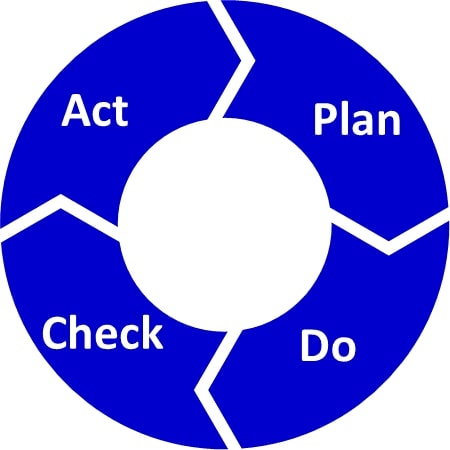What is Continuous Process Improvement?

Many people will agree that using the phrase “It’s how we’ve always done it,” is likely to end up causing more harm than good within a business setting. In truth, most successful companies take time to review and analyse their processes to practice continuous process improvement. In essence, small improvements along the way can produce full-scale benefits over time.
We’ll take a look at what continuous process improvement stands for, how to implement a continuous improvement model and why it is so imperative to do so.
Coming Up
1. Defining Continuous Process Improvement
2. What are the Benefits of Continuous Process Improvement?
3. What are the 4 Steps of Continuous Process Improvement?
4. What to Look For When Choosing a Continuous Process Improvement Tool?
5. Continuous Process Improvement Model
6. Continual or Continuous Improvement
7. Why It’s Important & Providing Value
8. Creating a Culture for Continuous Process Improvement in Practice
9. CPI Techniques & Applying Them
10. Principles of Continuous Process Improvement
Defining Continuous Process Improvement
Continuous process improvement is defined as, “The ongoing improvement of products, services or processes through incremental and breakthrough improvements.”
It doesn’t only mean that a business should make changes along the way when things aren’t working smoothly. Instead, continuous process improvement is an actual type of work style that is designed to continuously review results and rapidly adopt new measures when deemed necessary. The keyword here is continuous because ultimately broad-scale change and progress stem from small steps along the way that are all geared towards optimisation.
For some, it may be easy to conflate continuous process improvement as equivalent to other lean methodologies, including Kaizen and Six Sigma, for example. While these frameworks help to improve processes along the way, they can live inside the practice of continuous process improvement, but they are not the same.
Two main philosophies exist for continuous process improvement - formalised and adaptive. Formalised continuous process improvement is typically in line with Six Sigma, in which you have a set of techniques that are enacted for a quantifiable financial return. Adaptive continuous process improvement may pull from lean methodologies and approach improving processes on a case-by-case basis.
What are the Benefits of Continuous Process Improvement?
Conducting continuous process improvement will allow your business to spot inefficiencies and open the door to rectify them.
As such, there are multiple benefits that can come from this practice. Some benefits include:
- Reduced costs
- Less errors
- Better outcomes
- More efficient processes
- Reduced bottlenecks
- More satisfied customers
- More productive and happy employees
The impact of continuous process improvement and its related benefits will depend on where you choose to focus. It will also depend on your current operations and processes because they define the room for improvement.
The great news is that no matter how big or small your improvements may be, they have the potential to have an impact on your employees, as well as your customers.
What are the 4 Steps of Continuous Process Improvement?
As one of the most popular tools for continuous process improvement, many rely on the plan-do-check-act (PDCA) cycle. This stands for:
1. Plan:
Identify an opportunity for change.
2. Do:
Implement the change on a small scale to test.
3. Check:
Review results by analysing data to determine if the change was successful. One of the easiest ways to approach this step is by leveraging a data automation software solution that can showcase real-time data and analytics as processes run their cycles.
4. Act:
If the change proves successful based on the data, then it’s time to implement it on a broader scale. If it wasn’t as effective as hoped for, later only, try again!
Data automation software can play a role in every step of the PDCA cycle. Beginning with a process map, these tools can help to visualise how a process runs and identify gaps for improvement. Then, you can use software tools as a sandbox to test or forecast how changes will impact the entire organisation. Once you’ve assessed data and results of the test, it may be time to roll out the improvement. Automation solutions can do this immediately when they are enacted to carry out processes automatically.
Rolling out changes within an organisation can be costly, timely and risky. But, when you use automation tools, you can solve these many risks because you can map out processes, use version control, and has forecasting models to predict how the change will impact the business. In this way, you can easily roll back or roll forward continuous process improvement without causing harm.

What to Look For When Choosing a Continuous Process Improvement Tool?
Tools that help with process improvement will assist you in planning, implementing, and tracking progress. There are multiple types of business and automation tools that can play a role in your continuous process improvement endeavours.
Here’s a look at some of the features you’ll want the tool of your choice to possess:
1. Map Functionality
Process mapping is an essential aspect of process improvement. It provides you with the ability to visualise how the process is running and map out the desired changes.
This way, you can identify the gaps and inefficiencies and plan for the changes before implementation. Map functionalities that allow you to assign roles and even explore conditional routes to choose the optimal path forward are the most helpful.
2. Straightforward Implementation
Your employees are likely going to have to deal with process changes soon, so the need to also train and learn a new tool will further exacerbate their schedules. Instead, choose an easy-to-use tool with an intuitive interface.
3. Automation Features
Automation is key to achieving operational effectiveness. Pick a tool that will help you identify, plan, and track changes, as well as implement them through automation. This way, you can streamline processes and optimise them.
4. Performance Analytics
Once you make updates to your processes, you’ll undoubtedly want to know if they are working as you had hoped. Performance analytics provides you with the data you’d want to answer such questions to evaluate the outcome of your improvements.
Continual or Continuous Improvement
It’s common for the word continuous and continuous to be used interchangeably. However, they do have a slight variation in meaning, as defined here:
- Continual: Of frequent recurrence, with breaks in between.
- Continuous: Without interruption, or in an entire-time or space.
Why It’s Important & Providing Value
The main goal of continuous process improvement is to provide higher value overall for a business. While it’s always desirable to achieve efficiency, that could come at the cost of decreased quality, if the change is implemented without a close eye or too quickly. One of the main benefits of continuous process improvement is that it happens incrementally.
For any organisation, there will be a need to improve processes across departments. But, there are always going to be constraints, whether it be in the form of time, money or resources. That’s why many companies approach continuous process improvement across events and use Value Stream Mapping to do so.
Value Stream Mapping helps to identify what is happening, what changes can feasibly occur and how you’ll be able to measure outcomes. When businesses break up their inner workings by events, it’s noticeable how interconnected processes are within the overarching system. This way, when one process is altered, it often necessitates change for the next and so on.
Creating a Culture for Continuous Process Improvement in Practice
Continuous improvement doesn’t come from one person per se. Yet, it does call for executives and managers to support a culture of continuous process improvement and empower employees to take the initiative.
In this way, those “on the ground” can point out where improvements can be made and feel supported to make suggestions.
To engrain these sentiments within the company culture, management can direct the team to:
1. Ask the Right Questions
- Questions that need to be asked relate to workflows and processes. Some right items include:
- How many people are involved in the process?
- What will teams be affected by changing any step along the process?
- Is the potential benefit of the change worth impacting the overall process workflow?
- How much time and money is spent on the workflow?
2. Ways to Approach Change
- Flowchart or Kanban board: Use a visual display to break down processes and outline who is responsible for each step. In this way, the whole team can better understand where the responsibility lies.
- Analysis: Use a data automation tool to quantify resources and results. With an automation tool, you can run various types of reports to gauge efficiency and find gaps that can be improved.
- Recommendations: The team is part of strategising solutions, as well as implementing the changes. Actionable steps here may include training sessions and the use of automation to increase the efficiency of a process. Automation tools can help to alleviate bottlenecks and remove critical person dependencies as the software system can carry out a procedure with little to no human intervention. It also removes low-value manual tasks, so the team can instead focus on high-value tasks such as trying new things for continuous improvement.

CPI Techniques & Applying Them
Continuous process improvement can be applied to various techniques. Here’s a look at some of the most common methods to consider:
Business Process Mapping: A business process map, or flowchart, is used to represent how and why your processes exist visually. When you outline a business process by using a diagram or business process mapping solution within an automation tool, you can quickly pinpoint the steps that are not working as well as they could be. Then, you can apply continuous process improvement to make necessary changes.
PDCA: As outlined above, the PDCA cycle stands for Plan, Do, Check, Act. It was first created for quality control, but it’s become one of the most popular methods for continuous process improvement.
DMAIC: DMAIC stands for Define, Measure, Analyse, Improve and Control. It happens as follows:
- Define: Define the problem or activity that needs improvement. This may require feedback from customers or using a value stream map.
- Measure: Review how big of an issue or impact the problem may be creating.
- Analyse: Use root cause analysis or measurement of data to determine how and why problems are occurring.
- Improve: Address and eliminate root causes by isolating the many factors involved in an event to find what’s causing the problem.
- Control: Implement an improved process and measure performance over time.
Root Cause Analysis: Gather a small team to conduct root cause analysis, or to identify where problems are occurring within a process. This requires creating the right side, performing analysis, and assigning roles to each team member to make sure that analysis moves forward. Once the solution has been designed, it will take time to implement the new process.
Principles of Continuous Process Improvement
No matter what methodology you choose to implement to practice continuous process improvement, the overall principles remain unchanged.
These values exist at the core of CPI:
- Small changes: Improvements happen with small, incremental changes. With minor changes that occur continuously, there’s no need for significant paradigm shifts.
- Employees matter: Employees are critical to continuous process improvement. Employees should feel empowered to identify opportunities for development. This involves engaging with your staff and allowing their voices to not only be heard but also to create change through actionable steps.
- Incremental = inexpensive: This principle also stems from an engaged employee base. Most employees work within processes every day, and that’s why it’s easier for them to see where inefficiencies lie. More often than not, they may find ways to eliminate steps instead of adding more to increase efficiency. Small incremental changes are naturally less expensive.
- Employee ownership: When your staff is involved in coming up with changes, they are more likely to see the value of differences and be open to rolling them out. This consists of the idea of ownership and leads to sustainable improvement. Automation tools can also play a role in sustaining change as processes that are automated become standardised and ingrained within the organisation.
- Improvement is reflective: Everyone within an organisation is busy with the many tasks on their plates. By implementing solutions that involve increased collaboration or visibility, it’s easier for team members to see how their actions impact positive results. Organisations that use continuous improvement software/data automation solutions can allow all stakeholders to stay abreast of changes and positive impacts in real-time with dashboards and reports.
- Measurable and repeatable: Small improvements need to be measured to see if they are doing what they intend to do. With the help of technology solutions like automation, you can use tools to see how success is happening with continuous process improvement. This could involve making a change to how accounts receivables are collected by adding an automated solution. Then, you can track average days until payment to see if the new process flow is producing faster results, for example.
The Wrap Up
If you look at organisations like a car, then the engine can be considered its processes. How you position the engine within the hood of the vehicle will impact its performance. Continuous process improvement is the framework in which all your organisation’s processes and people reside. It involves creating an environment in which employees feel engaged, empowered and enthusiastic about suggesting ideas that will make the car perform better.
These changes are not a one and done deal, but rather, they rely on the consistent oversight of an organisation’s processes. With small, incremental and measurable improvements, the overall business will lean towards outcomes that can provide the most significant possible value to all stakeholders.
FAQ
Intelligent reconciliation solution
Intelligent rebate management solution
Intelligent financial automation solution
Intelligent Financial Automation Solution
Intelligent financial automation solution
Intelligent financial automation solution
Intelligent financial automation solution
Intelligent financial automation solution
Intelligent regulatory reporting solution
Free up time and reduce errors
Recommended for you

Request a Demo
Book a 30-minute call to see how our intelligent software can give you more insights and control over your data and reporting.

Reconciliation Data Sheet
Download our data sheet to learn how to automate your reconciliations for increased accuracy, speed and control.

Regulatory Reporting Data Sheet
Download our data sheet to learn how you can prepare, validate and submit regulatory returns 10x faster with automation.

Financial Automation Data Sheet
Download our data sheet to learn how you can run your processes up to 100x faster and with 98% fewer errors.

Financial Automation Data Sheet
Download our data sheet to learn how you can run your processes up to 100x faster and with 98% fewer errors.

Financial Automation Data Sheet
Download our data sheet to learn how you can run your processes up to 100x faster and with 98% fewer errors.

Financial Automation Data Sheet
Download our data sheet to learn how you can run your processes up to 100x faster and with 98% fewer errors.

Financial Automation Data Sheet
Download our data sheet to learn how you can run your processes up to 100x faster and with 98% fewer errors.

Financial Automation Data Sheet
Download our data sheet to learn how you can run your processes up to 100x faster and with 98% fewer errors.

Rebate Management Data Sheet
Download our data sheet to learn how you can manage complex vendor and customer rebates and commission reporting at scale.

Top 10 Automation Challenges for CFOs
Learn how you can avoid and overcome the biggest challenges facing CFOs who want to automate.
.svg)









